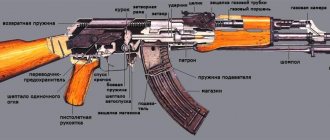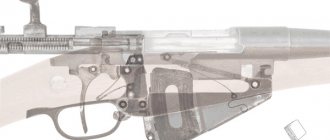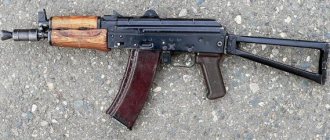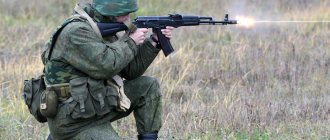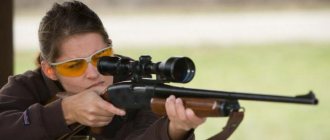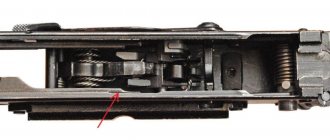Lesson on the topic “Kalashnikov assault rifle. Operation of machine parts and mechanisms"
Self-analysis of the lesson
1. Class 10 B of physics and mathematics. In the class there are ___ students: __ boys, __ girls.
The general educational level of the class is high. Achievement in life safety is 100%, quality of knowledge is 100%.
2. In the 2009-2010 academic year, a new life safety program was introduced for grades 10-11. It involves studying topics related to preparation for military service separately in the OBC section
(boys and girls). Therefore, the program is currently being tested.
3. The topic of the training session is the Kalashnikov assault rifle, the operation of the parts and mechanisms of the assault rifle
. This is the second lesson in the block “Armament of motorized rifle units of the Armed Forces of the Russian Federation.”
The material being studied is one of the main sections of the “Fundamentals of Military Service”, which determines the future quality of training sessions.
As I already said, this topic is supposed to be studied separately by boys and separately by girls. I got out of this situation by constructing the lesson in an integrated way, outlining the motivation for the girls in the form of the role of paramedics on the battlefield.
4. Type of lesson - learning new material.
5. Goals:
1 training: gain experience in handling weapons, become familiar with the requirements for safety measures when handling weapons and their technical characteristics and capabilities
2 developmental: development of students’ constructive and technical skills, logical thinking and creative imagination.
3 educational: education of patriotism based on the study of outstanding achievements of Russian military art.
6. Each stage of the lesson was subordinated to the implementation of these goals.
6.1. At the organizational stage, the students were set up for a life safety lesson.
6.2. At the updating stage, a relationship was achieved by consolidating the previous material and the topic of today's lesson.
6.3. When the topic and objectives of the training session were named, students were motivated. Motivation was based, firstly, on the boys’ interest in technology, incl. - to weapons; secondly, on the need to implement the acquired knowledge during live firing. The motivation of the girls is based on the need to fulfill the role of paramedics. The verbal method, the method of forming cognitive interest, was used.
6.4. At the stage of learning new material, there were explanations from the teacher, a demonstration of disassembling and assembling the machine, and students independently searching for answers to the questions posed. Teaching methods – audiovisual (verbal and visual), independent work.
6.5. Completing the practical task required dividing students into groups (by gender ).
Assistants (consultants) were selected in advance to help the groups. At this stage, control was carried out by the teacher, self- and mutual control of students.
6.6. Refl E
Xia was carried out at the end of the lesson at the stage of summing up the lesson and during test control.
6.7. Homework of a creative nature, differentiated: for boys and girls, according to the level of difficulty - for those who wish.
I believe that the goals set were achieved during the training session. Motivation for activity is provided at all stages of the lesson. The educational material is presented in an accessible manner.
For clarity, a computer presentation, a mock-up of an AK, a magazine with cartridges, handouts, and posters were used. Interdisciplinary connections were used - with history, physics, foundations of state and law, computer science and ICT.
To improve the quality of the educational session, various types of activities were implemented - from reproductive to constructive, which made it possible to carry out refl E
xia at different stages of the lesson.
In addition, the students’ activities were organized based on the interests, temperament, and potential capabilities of the children (communicative, organizational, artistic
?). Forms of organizing educational activities: frontal, group, individual. Differentiation was carried out at the stage of performing practical tasks and in homework.
Visual monitoring of students’ activities, self-control, mutual control, and mutual assessment are organized.
The pace of the lesson was optimal; there was no overload of students.
Quite often, young people have the wrong associations with weapons: accessibility, permissiveness. This negatively impacts how they handle the layout. I believe that by conducting the lesson, I played a positive role in resolving this issue.

